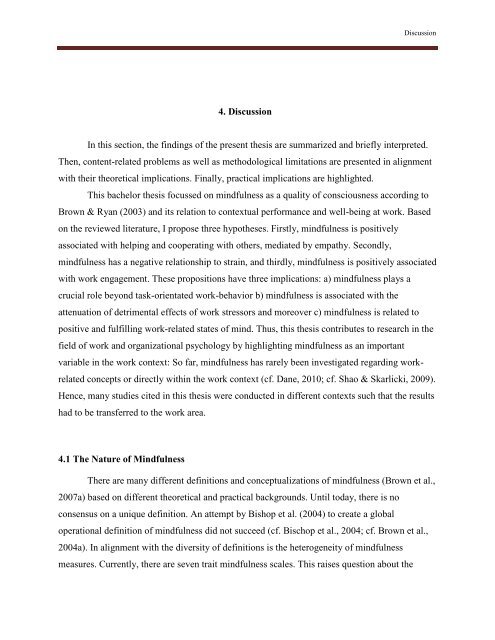Download - KOPS - Universität Konstanz
Download - KOPS - Universität Konstanz
Download - KOPS - Universität Konstanz
You also want an ePaper? Increase the reach of your titles
YUMPU automatically turns print PDFs into web optimized ePapers that Google loves.
4. Discussion<br />
Discussion<br />
In this section, the findings of the present thesis are summarized and briefly interpreted.<br />
Then, content-related problems as well as methodological limitations are presented in alignment<br />
with their theoretical implications. Finally, practical implications are highlighted.<br />
This bachelor thesis focussed on mindfulness as a quality of consciousness according to<br />
Brown & Ryan (2003) and its relation to contextual performance and well-being at work. Based<br />
on the reviewed literature, I propose three hypotheses. Firstly, mindfulness is positively<br />
associated with helping and cooperating with others, mediated by empathy. Secondly,<br />
mindfulness has a negative relationship to strain, and thirdly, mindfulness is positively associated<br />
with work engagement. These propositions have three implications: a) mindfulness plays a<br />
crucial role beyond task-orientated work-behavior b) mindfulness is associated with the<br />
attenuation of detrimental effects of work stressors and moreover c) mindfulness is related to<br />
positive and fulfilling work-related states of mind. Thus, this thesis contributes to research in the<br />
field of work and organizational psychology by highlighting mindfulness as an important<br />
variable in the work context: So far, mindfulness has rarely been investigated regarding work-<br />
related concepts or directly within the work context (cf. Dane, 2010; cf. Shao & Skarlicki, 2009).<br />
Hence, many studies cited in this thesis were conducted in different contexts such that the results<br />
had to be transferred to the work area.<br />
4.1 The Nature of Mindfulness<br />
There are many different definitions and conceptualizations of mindfulness (Brown et al.,<br />
2007a) based on different theoretical and practical backgrounds. Until today, there is no<br />
consensus on a unique definition. An attempt by Bishop et al. (2004) to create a global<br />
operational definition of mindfulness did not succeed (cf. Bischop et al., 2004; cf. Brown et al.,<br />
2004a). In alignment with the diversity of definitions is the heterogeneity of mindfulness<br />
measures. Currently, there are seven trait mindfulness scales. This raises question about the

















